A Roman biographer of Emperor Hadrian wrote that the wall was built ‘to separate Romans from barbarians’. At every Roman mile, there was a mile castle, guarded by at least eight men. Between each mile castle there were two equidistant turrets. The Newcastle Arts Centre occupies the site of a Roman mile castle.
Photographs, illustration and text about the Savings Bank.
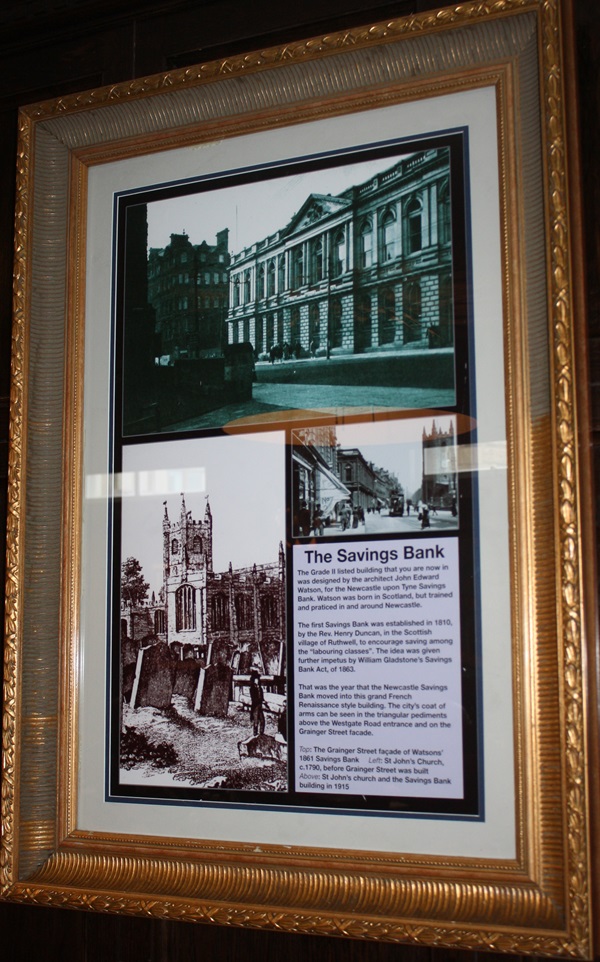
The text reads: The Grade II listed building that you are now in was designed by the architect John Edward Watson, for the Newcastle upon Tyne Savings Bank. Watson was born in Scotland, but trained and practiced in and around Newcastle.
The first Savings Bank was established in 1810, by the Rev. Henry Duncan, in the Scottish village of Ruthwell, to encourage saving among the “labouring classes”. The idea was given further impetus by William Gladstone’s Savings Bank Act, of 1863.
That was the year that the Newcastle Savings Bank moved into this grand French Renaissance style building. The city’s coat of arms can be seen in the triangular pediments above Westgate Road entrance and on the Grainger Street façade.
Top: The Grainger Street façade of Watsons’ 1861 Savings Bank
Left: St John’s Church, c.1790, before Grainger Street was built
Above: St John’s church and the Savings Bank building in 1915.
Illustrations and text about The Infirmary.
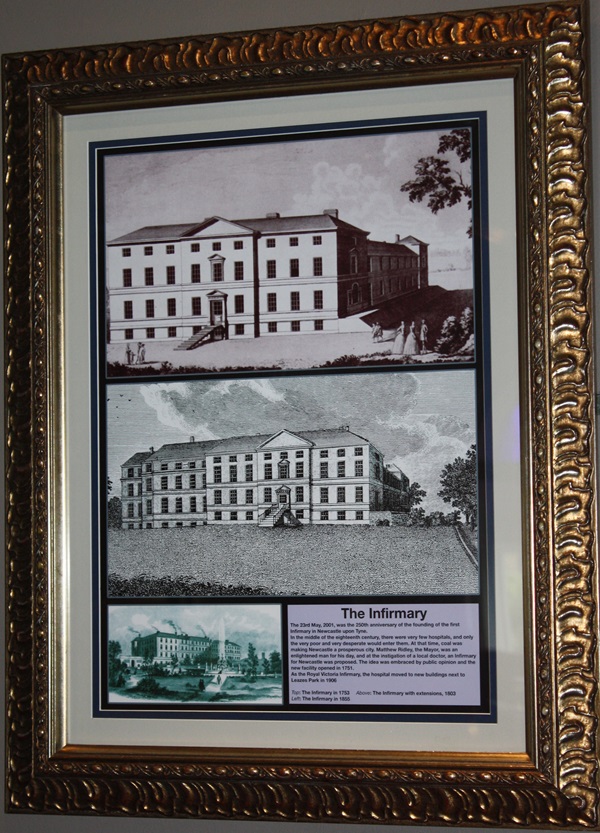
The text reads: The 23rd May, 2001, was the 250th anniversary of the founding of the first Infirmary in Newcastle upon Tyne.
In the middle of the eighteenth century, there were very few hospitals, and only the very poor and very desperate would enter them. At that time, coal was making Newcastle a prosperous city. Matthew Ridley, the Mayor, was an enlightened man for his day, and at the instigation of a local doctor, an infirmary for Newcastle was proposed. The idea was embraced by public opinion and the new facility opened in 1751.
As the Royal Victoria Infirmary, the hospital moved to new buildings next to Leazes Park in 1906.
Top: The Infirmary in 1753
Above: The Infirmary with extensions, 1803
Left: The Infirmary in 1855.
Illustrations, print and text about Daniel Defoe.
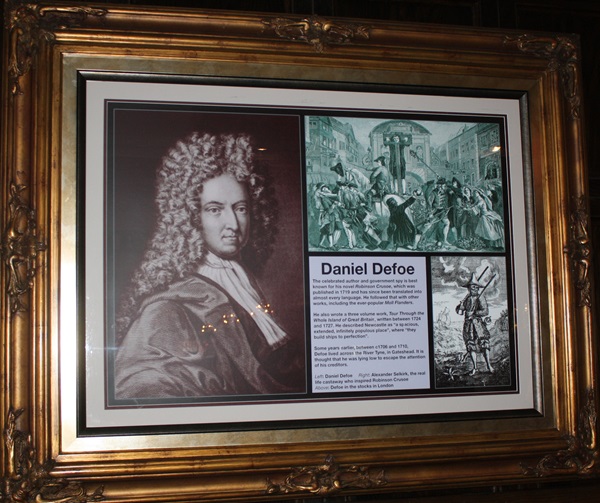
The text reads: The celebrated author and government spy is best known for his novel Robinson Crusoe, which was published in 1719 and has since been translated into almost every language. He followed that with other works, including the ever-popular Moll Flanders He also wrote a three volume work, Tour Through the Whole Island of Great Britain, written between 1724 and 1727. He described Newcastle as “a spacious, extended, infinitely populous place”, where “they build ships to perfection”.
Some years earlier, between c1706 and 1710, Defoe lived across the River Tyne, in Gateshead. It is thought that he was lying low to escape the attention of his creditors.
Left: Daniel Defoe
Right: Alexander Selkirk, the real life castaway who inspired Robinson Crusoe
Above: Defoe on the stocks in London.
Prints and text about the Blacketts of Newcastle.
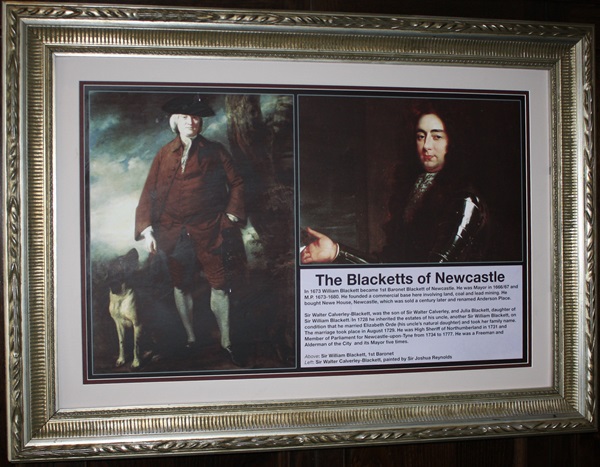
The text reads: In 1673 William Blackett became 1st Baronet Blackett of Newcastle. He was Mayor in 1666/67 and M.P. 1673-1680. He founded a commercial base here involving land, coal and lead mining. He bought Newe House, Newcastle, which was sold a century later and renamed Anderson Place.
Sir Walter Calverley-Blackett, was the son of Sir Walter Calverley, and Julia Blackett, daughter of Sir William Blackett. In 1728 he inherited the estates of his uncle, another Sir William Blackett, on condition that he married Elizabeth Orde (his uncle’s natural daughter) and took her family name. The marriage took place on August 1729. He Was High Sheriff of Northumberland in 1731 and Member of Parliament for Newcastle-upon-Tyne from 1734 to 1777. He was a Freeman and Alderman of the City and its Mayor five times.
Above: Sir William Blackett, 1st Baronet
Left: Sir Walter Calverley-Blackett, painted by Sir Joshua Reynolds.
Prints, illustrations and text about Jean-Paul Marat.
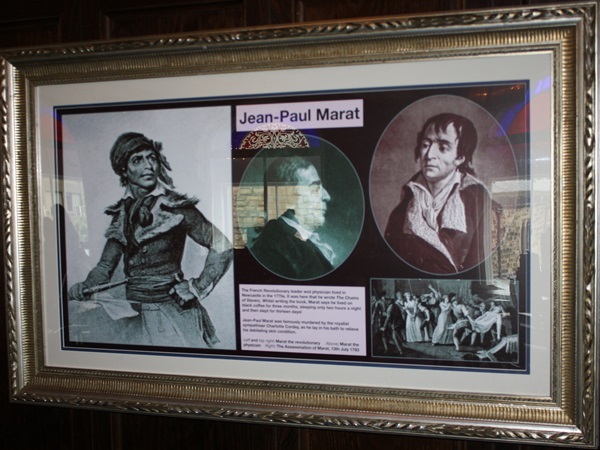
The text reads: The French Revolutionary leader and physician lived in Newcastle in the 1770s. It was here that he wrote The Chains of Slavery. Whilst writing the book, Marat says he lived on black coffee for three months, sleeping only two hours a night and then slept for thirteen days!
Jean-Paul Marat was famously murdered by the royalist sympathiser Charlotte Corday, as he lay in his bath to relieve his debilitating skin condition.
Left and top right: Marat the Revolutionary
Above; Marat the Physician
Right: The Assassination of Marat, 13th July 1793.
Photographs, illustrations and text about William Bell Scott.
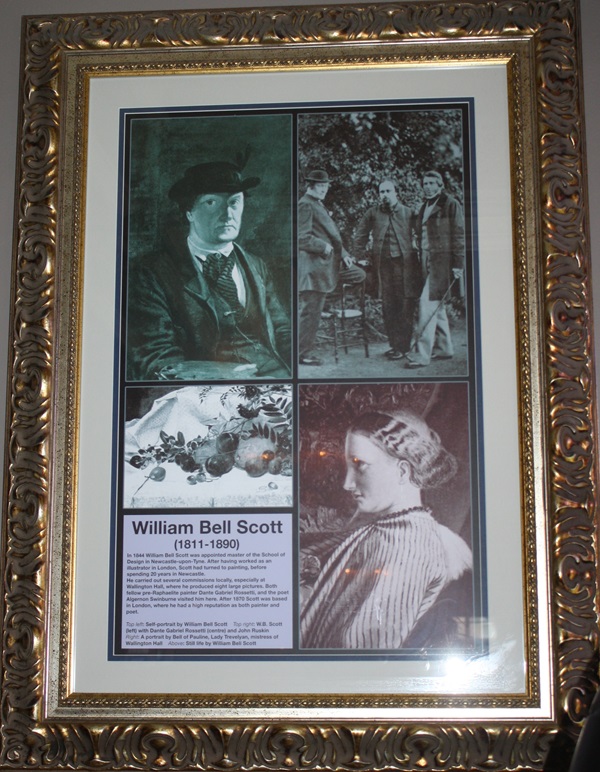
The text reads: In 1844 William bell Scott was appointed master of the School of Design in Newcastle-upon-Tyne. After having worked as an illustrator in London, Scott had turned to painting, before spending 20 years in Newcastle.
He carried out several commissions locally, especially at Wallington Hall, where he produced eight large pictures. Both fellow pre-Raphaelite painter Dante Gabriel Rossetti, and the poet Algernon Swinburne visited him here. After 1870 Scott was based in London, where he had a high reputation as both painter and poet.
Top left: Self-portrait by William Bell Scott
Top right: W.B. Scott (left) with Dante Gabriel Rossetti (Centre) and John Ruskin
Right: A portrait by Bell of Pauline, Lady Trevelyan, mistress of Wallington Hall
Above: Still life by William Bell Scott.
Photographs and text about the Literary and Philosophical Society.
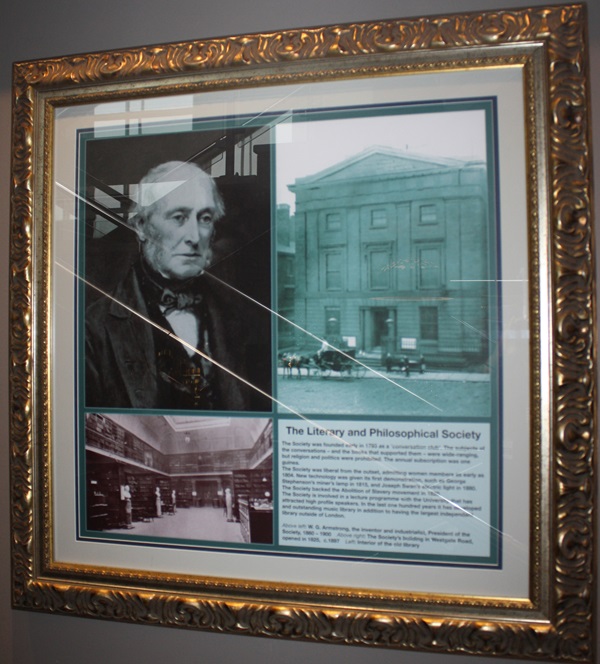
The text reads: The Society was founded early in 1793 as a ‘conversation club’. The subjects of the conversations – and the books that supported them – were wide-ranging, but religion and politics were prohibited. The annual subscription was one guinea.
The Society was liberal from the outset, admitting women members as early as 1804. New technology was given its first demonstration, such as George Stephenson’s miner’s lamp in 1815, and Joseph Swan’s electric light in 1880. The Society backed the Abolition of Slavery movement in 1820.
The society is involved in a lecture programme with the University that has attracted high profile speakers. In the last one hundred years it has developed and outstanding music library in addition to having the largest independent library outside of London.
Above left: W.G. Armstrong, the inventor and industrialist, President of the Society, 1860-1900
Above right: The Society’s building in Westgate Road, opened in 1825, c.1897
Left: Interior of the old library.
Prints, photograph and text about John Dobson.
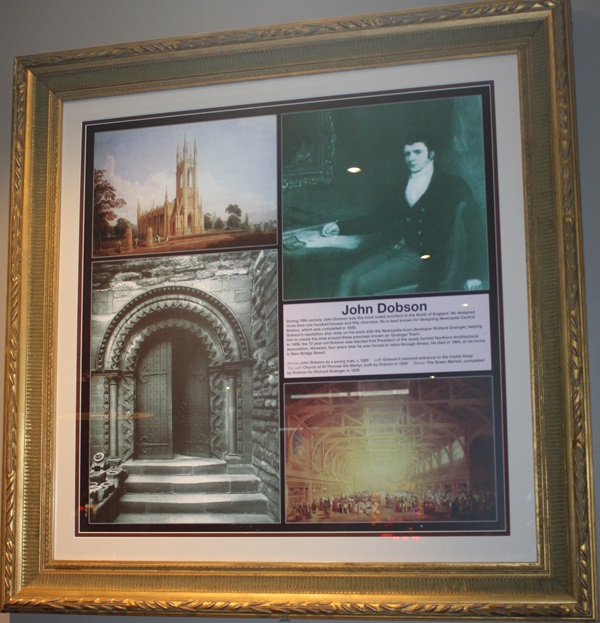
The text reads: During the 19th Century John Dobson was the most noted architect in the North of England. He designed more than one hundred houses and fifty churches. He is best known for designing Newcastle Central Station, which was completed in 1850.
Dobson’s reputation also rests on his work with the Newcastle-born developer Richard Grainger, helping him to create the area around these premises known as ‘Grainger Town’.
In 1859, the 72 year-old Dobson was elected first President of the newly formed Northern Architectural Association. However, four years later he was forced to retire through illness. He died in 1865, at his home in New Bridge Street.
Above: John Dobson as a young man, c.1820
Left: Dobson’s restored entrance to the Castle Keep
Top Left: Church of St Thomas the Martyr, built by Dobson in 1830
Below: The Green Market, completed by Dobson for Richard Grainger in 1835.
Photographs and text about Joseph Swan.
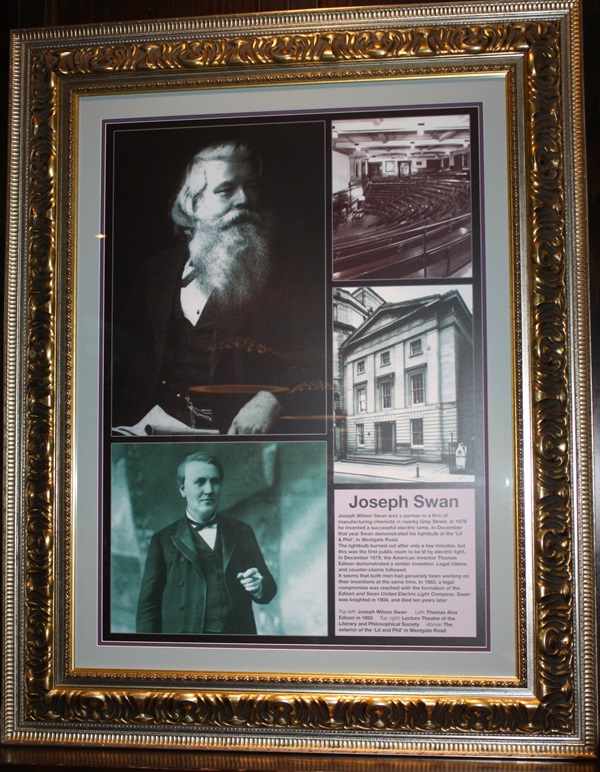
The text reads: Joseph Wilson Swan was a partner in a firm of manufacturing chemists in nearby Grey Street. In 1878 he invented a successful electric lamp. In December that year Swan demonstrated his lightbulb at the ‘Lit & Phil’, in Westgate Road.
The lightbulb burned out after only a few minutes, but this was the first public room to be lit by electric light. In December 1879, the American inventor Thomas Edison demonstrated a similar invention. Legal claims and counter-claims followed.
It seems that both men had genuinely been working on their inventions at the same time. In 1883, a legal compromise was reached with the formation of the Edison and Swan united Electric Light Company. Swan was knighted in 1904, and died ten years later.
Top left: Joseph Wilson Swan
Left: Thomas Alva Edison in 1892
Top right: Lecture Theatre of the Literary and Philosophical Society
Above: The exterior of the ‘Lit and Phil’ in Westgate Road.
A print and text about Earl Grey.
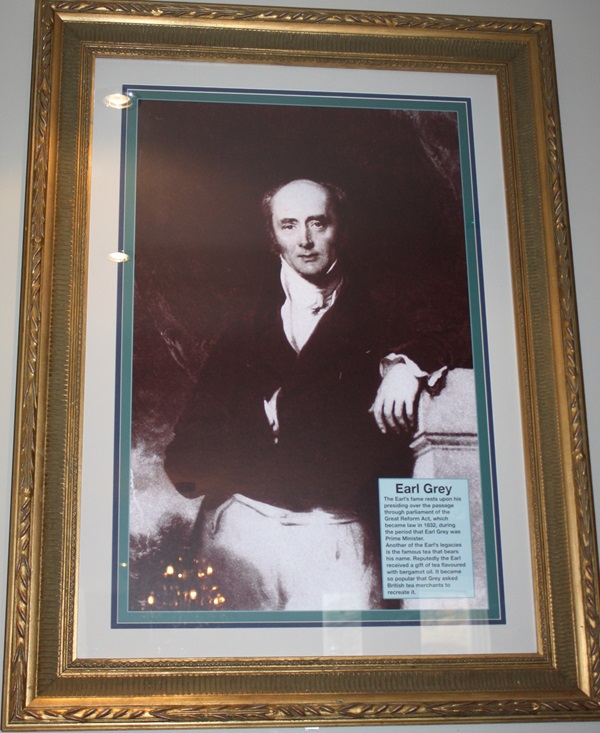
The text reads: The Earl’s fame rests upon his presiding over the passage through parliament of the Great Reform Act, which became law in 1832, during the period Earl Grey was Prime Minister.
Another of the Earl’s legacies is the famous tea that bears his name. Reputedly the Earl received a gift of tea flavoured with bergamot oil. It became so popular that Grey asked British tea merchants to recreate it.
Illustrations and text about George Stephenson.
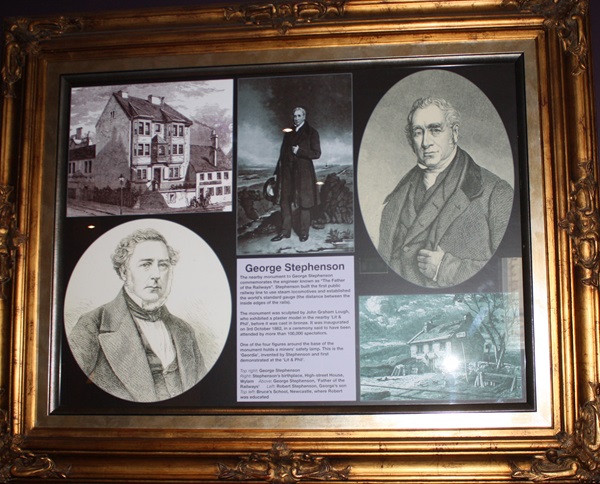
The text reads: The nearby monument to George Stephenson commemorates the engineer known as “The Father of the Railways”. Stephenson built the first public railway line to use steam locomotives and established the world’s standard gauge (the distance between the inside edges of the rails).
The monument was sculpted by John Graham Lough, who exhibited a plaster model in the nearby ‘Lit & Phil’, before it was cast in bronze. It was inaugurated on 3rd October 1862, in a ceremony said to have been attended by more than 100,000 spectators.
One of the four figures around the base of the monument holds a miners’ safety lamp. This is the ‘Geordie’, invented by Stephenson and first demonstrated at the ‘Lit & Phil’.
Top right: George Stephenson
Right: Stephenson’s birthplace, High-street House, Wylam
Above: George Stephenson, ‘Father of the Railways’
Left: Robert Stephenson, George’s son
Top left: Bruce’s School, Newcastle, where Robert was educated.
Prints and text about Hadrian’s Wall.
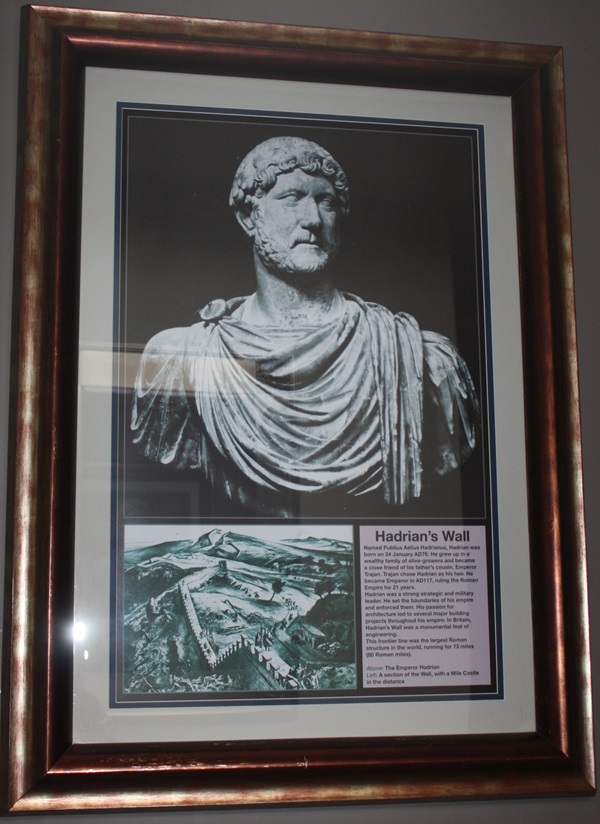
The text reads: Named Publius Aelius Hadrianus, Hadrian was born 24 January AD76. He grew up in a wealthy family of olive-growers and became a close friend of his father’s cousin, Emperor Trajan. Trajan chose Hadrian as his heir. He became Emperor in ad AD117, ruling the Roman Empire for 21 years.
Hadrian was a strong strategic and military leader. He set the boundaries of his empire and enforced them. His passion for architecture led to several major building projects throughout his empire. In Britain, Hadrian’s Wall was a monumental feat of engineering.
This frontier line was the largest Roman structure in the world, running for 73 miles (80 Roman miles).
Above: The Emperor Hadrian
Left: A section of the wall, with a mile castle in the distance.
Paintings and text about Cullercoats.
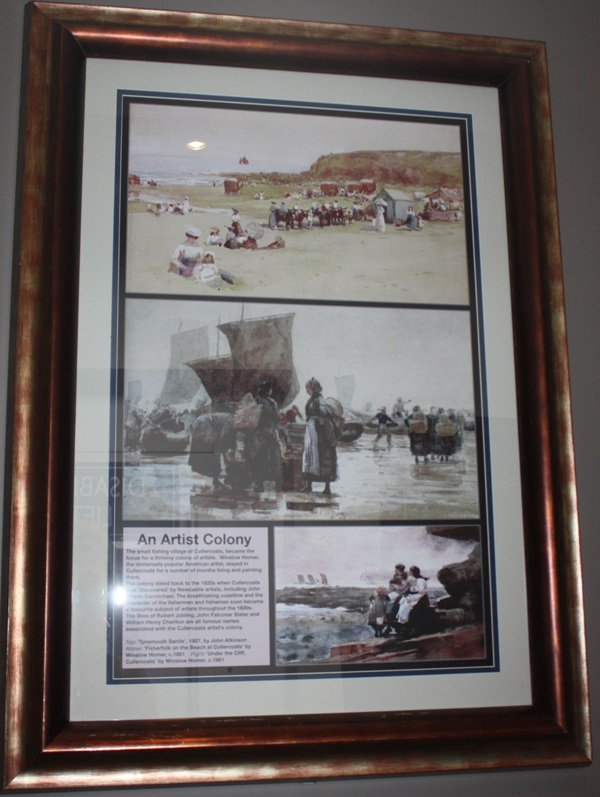
The text reads: The small fishing village of Cullercoats, became the focus of for a thriving colony of artists. Winslow Homer, the immensely popular American artist, stayed in Cullercoats for a number of months living and painting there.
The colony dated back to the 1820’s when Cullercoats was ‘discovered’ by Newcastle artists, including John Wilson Carmichael. The breath taking coastline and the character of the fisherman and fishwives soon became a favourite subject of artists throughout the 1800’s. The likes of Robert Jobling, John Falconer Slater and William Henry Charlton are all famous names associated with the Cullercoats artist’s colony.
Top: ‘Tynemouth Sands’, 1907, by John Atkinson
Above: ‘Fisherfolk on the Beach at Cullercoats’ by Winslow Homer, c.1881
Right: ‘Under the Cliff, Cullercoats’ by Winslow Homer, c.1881.
Photographs and text about Westgate Road.
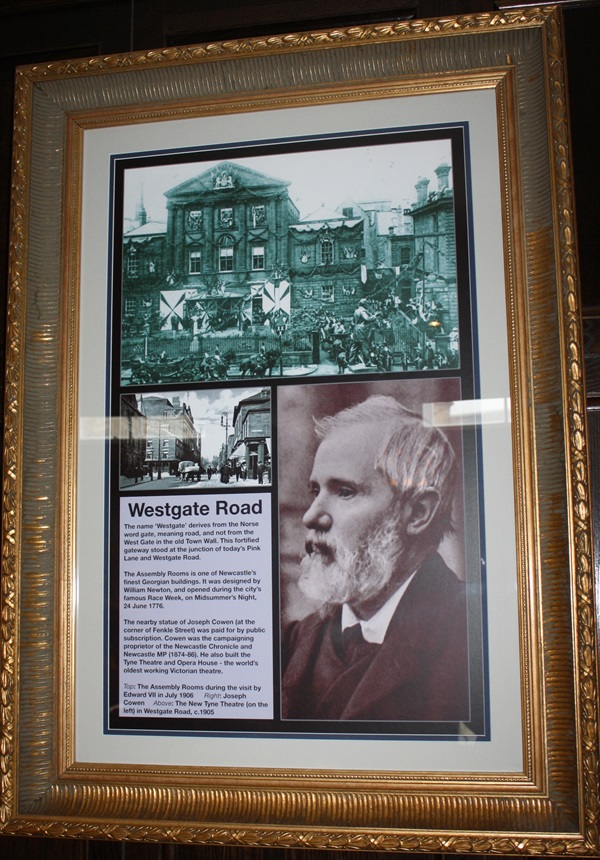
The text reads: The name ‘Westgate’ derives from the Norse word gate, meaning road, and not from the West Gate in the old Town Wall. This fortified gateway stood at the junction of today’s Pink Lane and Westgate Road.
The Assembly Rooms is one of Newcastle’s finest Georgian buildings. It was designed by William Newton, and opened during the city’s famous Race Week, on Midsummer’s Night, 24 June 1776.
The nearby statue of Joseph Cowen (at the corner of Fenkle Street) was paid for by public subscription. Cowen was the campaigning proprietor of the Newcastle Chronicle and Newcastle MP 91874-86). He also built the Tyne Theatre and Opera House – the world’s oldest working Victorian theatre.
Top: The Assembly Rooms during the visit by Edward VII in July 1906
Right: Joseph Cowen
Above: The New Tyne Theatre (on the left) in Westgate Road, c.1905.
An acrylic painting entitled Dusk Landscape by Gabrielle Thomson.
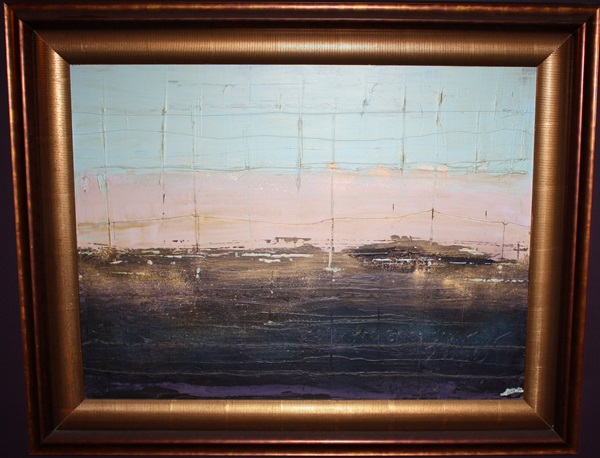
Commissioned by J D Wetherspoon for The Mile Castle, 2009.
Gabrielle is a Fine Artist and Graphic Designer.
Gabrielle’s work is highly abstract, but contains clear figurative references. Her images are concerned with the line and space, the fundamentals of art, and as such with the fundamentals of the visible creation
External photograph of the building – main entrance.
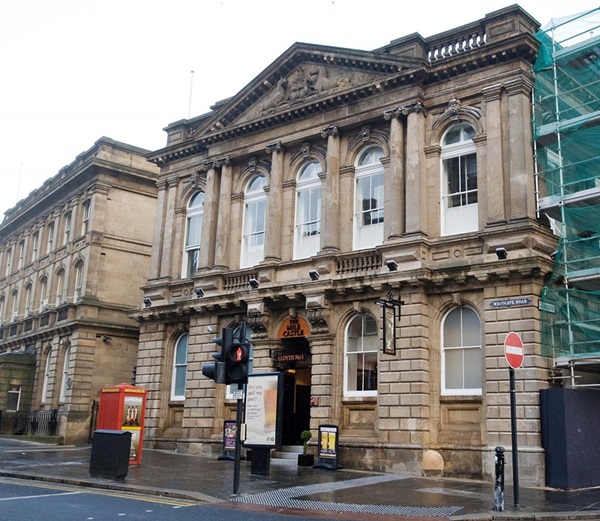
If you have information on the history of this pub, then we’d like you to share it with us. Please e-mail all information to: pubhistories@jdwetherspoon.co.uk